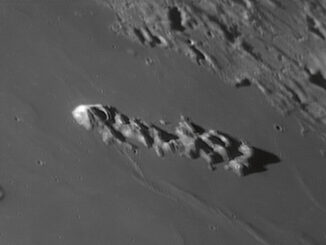
The pairing of the waxing gibbous Moon and Aldebaran will be close enough for them to be seen in the same field of view of telescopes at magnifications of 35× or less, but it is in binoculars where the full beauty of the Moon’s stellar backdrop will become apparent.
Observers with low power, wide-field binoculars will also see the V-shaped Hyades open star cluster in the same field of view. Note that the star field is strewn with interesting wide double stars, particularly in the vicinity of naked-eye pair θ1 and θ2 Tauri.
While it may seem that Aldebaran is a member of the Hyades, it is merely a line-of-sight effect: the orange giant star and its dim red dwarf companion are 65 light-years away, whereas the 300 to 400 stars that comprise the cluster lie some 152 light-years from Earth.



